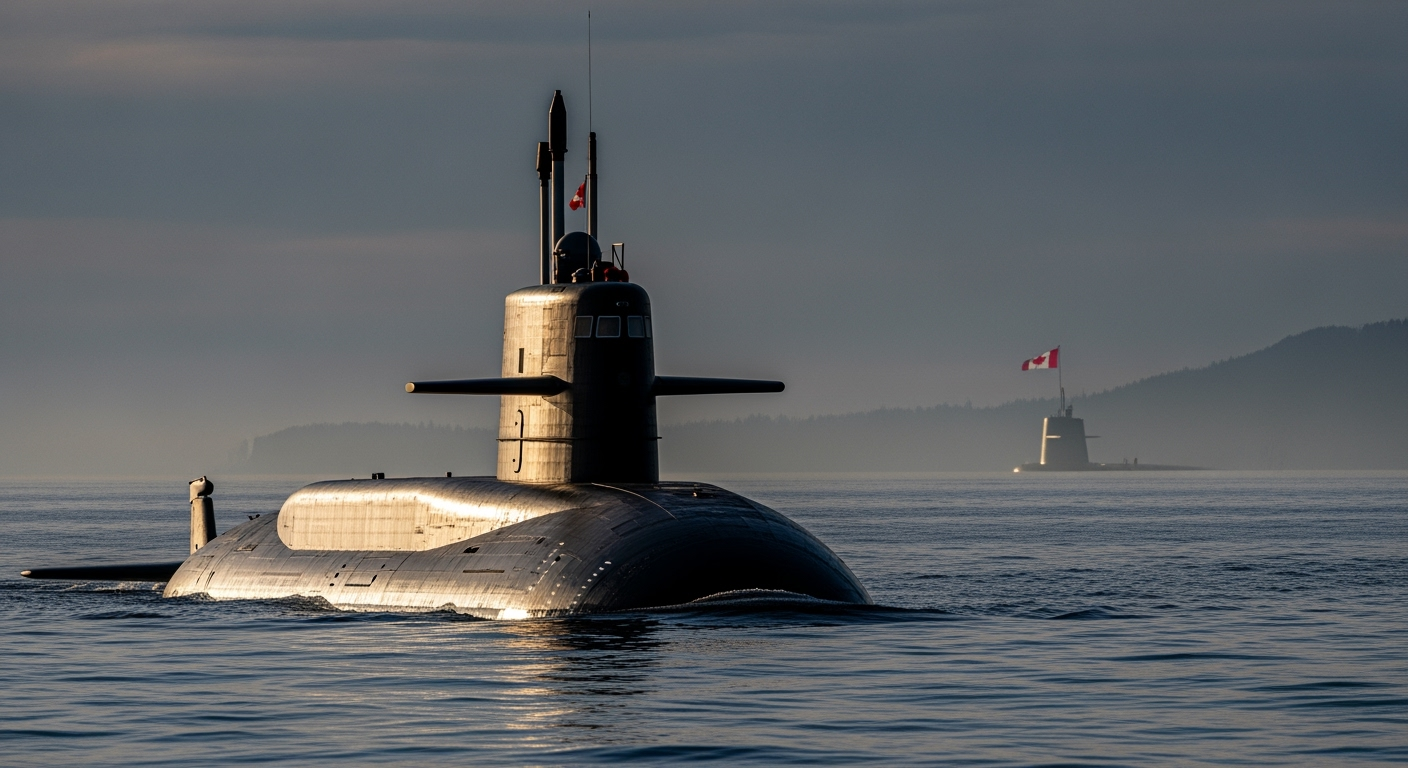Related Articles

Germany's Syrian Deportation Plan: A Tightrope Walk Between Politics and Harsh Realities




OTTAWA, ON – Canada is moving closer to a monumental decision that will reshape its naval capabilities for decades, as the federal government has officially shortlisted two international giants—Germany's ThyssenKrupp Marine Systems (TKMS) and South Korea's Hanwha Ocean Co., Ltd.—in the high-stakes competition to replace the Royal Canadian Navy’s aging submarine fleet. This strategic procurement, estimated to cost up to $60 billion CAD, aims to acquire as many as 12 conventionally-powered, Arctic-capable submarines, a critical move to safeguard Canada's sovereignty across its vast coastlines and reinforce its role on the global stage. With an urgent need to secure a new fleet by the mid-2030s, the selection process highlights a complex interplay of operational requirements, industrial benefits, delivery timelines, and evolving geopolitical partnerships.
Canada's current fleet of Victoria-class submarines, acquired used from the United Kingdom in 1998, is rapidly approaching the end of its service life, with decommissioning expected by the mid-to-late 2030s. These submarines have faced significant operational challenges and high maintenance costs over the years, making their replacement a top priority for national defense. The Royal Canadian Navy requires a new submarine fleet capable of extended range and endurance, deployable in the Arctic, and possessing stealth, persistence, and lethality as key capabilities. Canada's unique geographic position, bordered by the Atlantic, Arctic, and Pacific oceans, necessitates superior underwater surveillance and combat capabilities to detect, track, deter, and, if necessary, defeat adversaries across all three maritime domains. The accelerating impacts of climate change are making the Arctic increasingly accessible, raising concerns about growing military activities by actors like Russia and China, further underscoring the critical need for advanced under-ice capabilities. The Canadian Patrol Submarine Project (CPSP), established in 2021, aims to avoid any capability gap in Canada's submarine forces, with the first new submarine ideally delivered by 2035.
ThyssenKrupp Marine Systems (TKMS), a German company, is offering its Type 212CD submarine, a design developed jointly with Norway. This model is distinguished by its air-independent propulsion (AIP) system, allowing it to remain submerged for over three weeks, and is specifically engineered for operations in all oceans, including the demanding Arctic environment. The German Navy is slated to receive its first 212CD in 2028, with Norway following in 2029, showcasing the design's advanced stage of development and operational readiness. TKMS has actively courted Canada with a proposition extending beyond just the vessels, including plans for establishing a submarine maintenance facility within Canada and fostering partnerships with local shipyards. This offer aligns with Canada's emphasis on generating domestic job creation and long-term support infrastructure, appealing to the government's desire for significant economic returns from the massive procurement. German and Norwegian officials have also actively campaigned for Canada to join their existing alliance, framing the acquisition as a strategic move to bolster NATO interoperability and enhance Arctic security. TKMS has indicated it can deliver the first submarine "well in advance of 2035" if a contract is signed by 2026.
Challenging the established European contender is South Korea's Hanwha Ocean Co., Ltd., which is proposing its KSS-III submarine. A key selling point for Hanwha is its promise of an accelerated delivery timeline, asserting that it can provide four KSS-III submarines to Canada by 2035, with the first vessel potentially arriving as early as 2032 if a contract is secured in 2026. Hanwha further states that the entire fleet of up to 12 submarines could be delivered by 2043. The KSS-III boasts advanced features, including lithium-ion batteries, which reportedly offer superior cruising speed and significantly longer submerged endurance, allowing for more than 21 days underwater. These capabilities are particularly attractive for Canada's demanding Arctic operations. Unlike the German bid, Hanwha's proposal does not include manufacturing the submarines in Canada, instead focusing on establishing robust in-country maintenance, support, and upgrade capabilities. Hanwha's offering also brings a competitive price point, with its initial proposal valuing the purchase at $20 billion to $24 billion, depending on Canada's specific requirements.
The Canadian Patrol Submarine Project represents one of Canada's most significant defense procurements, with a potential price tag of $60 billion CAD. Beyond the substantial financial investment, the project involves intricate considerations of technical performance, delivery schedules, and the enduring geopolitical implications of Canada's choice. Both TKMS and Hanwha Ocean have undergone thorough assessments, and Canada's Prime Minister, Mark Carney, has personally visited the TKMS shipyard in Germany and is slated to visit Hanwha's facility in South Korea, underscoring the high-level attention given to this decision.
The Royal Canadian Navy's firm requirement for the first new submarine by 2035 means that delivery timelines are a critical factor, with both bidders striving to demonstrate their ability to meet or exceed this deadline. Canada is also keenly focused on maximizing economic benefits, seeking industrial partnerships, technology transfer, and job creation within its borders. The new Defence Investment Agency, launched in early October, will manage this complex procurement process. The decision also carries significant weight in terms of international partnerships: selecting a European NATO ally like Germany could further deepen transatlantic security ties, while opting for South Korea could signal a strategic shift towards closer engagement with a key Indo-Pacific partner. Regardless of the ultimate choice, interoperability with key allies, particularly the United States, remains a crucial requirement for Canada's future submarine fleet.
As the process moves towards a potential decision as early as late 2025 or early 2026, Canada stands at a pivotal juncture in defining its future maritime defense capabilities. The choice between German and South Korean submarines will not merely be about acquiring new vessels; it will reflect a careful balancing act between immediate operational needs, long-term strategic alliances, economic objectives, and the urgent imperative to protect Canada's sovereignty in an increasingly complex global security landscape. The selected fleet must not only meet the rigorous demands of Canada's three oceans, including the challenging Arctic, but also integrate seamlessly into the nation's broader defense strategy, ensuring a robust and capable Royal Canadian Navy for decades to come.